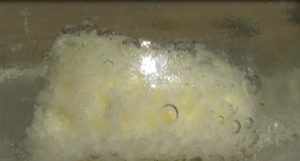Nitrogen trichloride
 Droplets of nitrogen trichloride forming along with other chloramine gases on a block of TCCA under ammonia
| |
| Names | |
|---|---|
| IUPAC name
Nitrogen trichloride
| |
| Other names
Agene
Nitrogen(III) chloride Trichlorine nitride Trichloramine Trichloroazane | |
| Properties | |
| NCl3 | |
| Molar mass | 120.365 g/mol |
| Appearance | Yellow oily liquid |
| Odor | Chlorine-like |
| Density | 1.653 g/cm3 |
| Melting point | −40 °C (−40 °F; 233 K) |
| Boiling point | 71 °C (160 °F; 344 K) |
| Immiscible, hydrolyzes | |
| Solubility | Soluble in benzene, chloroform, carbon disulfide, CCl4, ethanol, PCl3, sulfur dichloride |
| Vapor pressure | 150 mmHg (at 20 °C) |
| Thermochemistry | |
| Std enthalpy of
formation (ΔfH |
232 kJ/mol |
| Hazards | |
| Safety data sheet | None |
| Flash point | Non-flammable |
| Related compounds | |
| Related compounds
|
Nitrogen trifluoride Nitrogen tribromide Nitrogen triiodide |
| Except where otherwise noted, data are given for materials in their standard state (at 25 °C [77 °F], 100 kPa). | |
| Infobox references | |
Nitrogen trichloride (NCl3), sometimes called trichloramine, is a dangerously unstable liquid explosive with a reputation for detonating unexpectedly. It is important to know of its existence, as it can sometimes form accidentally.
Contents
Properties
Chemical
Nitrogen trichloride is only able to exist in basic conditions. Its formation and stability is very pH sensitive, lowering the ease at which a synthesis is reproduced.
It is hydrolyzed by hot water to release ammonia and hypochlorous acid.
- NCl3 + 3 H2O → NH3 + 3 HOCl
Physical
Nitrogen trichloride has a strong, unpleasant smell. It is a sickly yellow colored, viscous oil forming in droplets that sink in water.
Explosive
Nitrogen trichloride is know to explode spontaneously.
Availability
Transport of this explosive is not possible, so the liquid must be prepared on site.
Preparation
Many preparations of this compound are known, often with very basic lab chemicals. However, repeatability seems to be an issue, with different methods failing different people.
Chlorine gas acting upon an ammonium salt, such as the nitrate, chloride or sulfate (the sulfate perhaps being the preferred of the three) is said produce droplets of the liquid.
Electrolysis of ammonium chloride solutions can create NCl3.
Contact between solutions of ammonia and TCCA produces chloroamines, which depending on the concentrations and length of time left in contact, trichloramine can form.
The production danger of the explosive is dramatically increased as nitrogen trichloride is destroyed on contact with plastic (quite possibly dramatically) so an all glass setup must be used. This increases the danger from accidental detonations, as thick glass can shatter and produce deadly shrapnel.
Handling
Safety
Due to its ability to unexpectedly form from the interaction between common lab chemicals, it can be made accidentally in very simple experiments. It is therefore important to be able to recognize the substance if it forms and to be able to safely neutralize it.
Intentional production should only be done on the very small scale. The power of the explosive is often much above what one expects from a certain volume. The oil does not need to dry before becoming explosive, so droplets can detonate underwater, shattering the container it is in.
Contact with even traces of organic materials can cause a detonation, as well as sunlight, heat, shock and flame.
Storage
The substance should not be stored due to risk of detonation. Even without detonating, the substance will decompose at standard conditions.
Disposal
Hot water, and eventually warm water, hydrolyzes the explosive.
If the trichloride is underwater, the solution can slowly be made acidic to destroy the oil.
Nitrogen trichloride left out in sunlight will decompose.